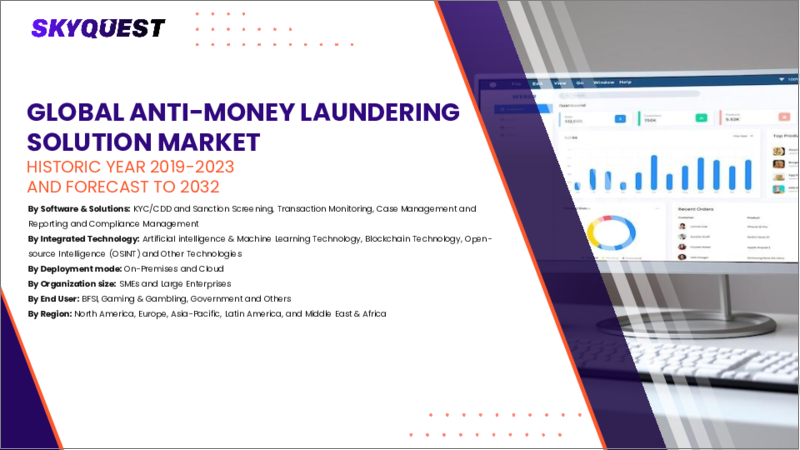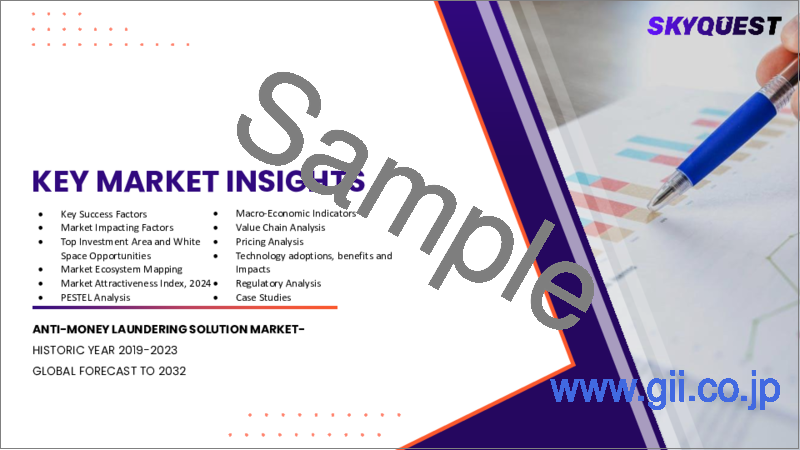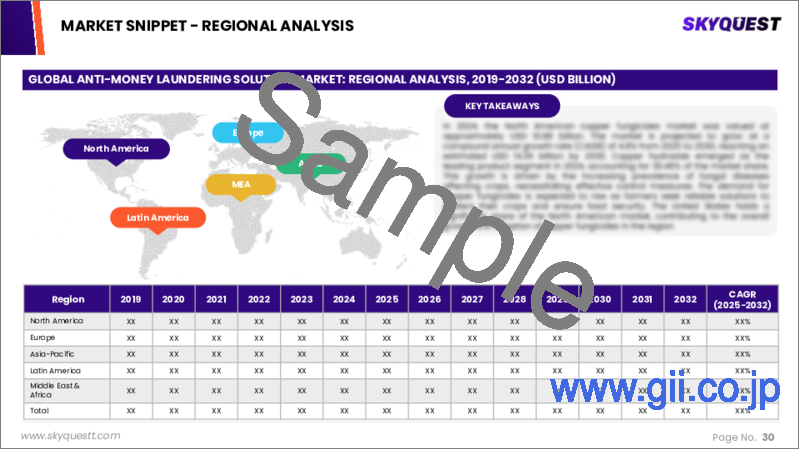|
|
市場調査レポート
商品コード
1630597
マネーロンダリング対策ソリューションの市場規模、シェア、成長分析、提供別、ソリューション別、サービス別、展開モード別、組織規模別、エンドユーザー別、地域別 - 産業予測、2025~2032年Anti-Money Laundering Solution Market Size, Share, Growth Analysis, By Offerings, By Solution, By Services, By Deployment mode, By Organization size, By End-user, By Region - Industry Forecast 2025-2032 |
||||||
|
|||||||
| マネーロンダリング対策ソリューションの市場規模、シェア、成長分析、提供別、ソリューション別、サービス別、展開モード別、組織規模別、エンドユーザー別、地域別 - 産業予測、2025~2032年 |
|
出版日: 2025年01月10日
発行: SkyQuest
ページ情報: 英文 172 Pages
納期: 3~5営業日
|
全表示
- 概要
- 目次
マネーロンダリング対策ソリューションの世界市場規模は、2023年に31億1,000万米ドルと評価され、2024年の36億4,000万米ドルから2032年には126億8,000万米ドルに成長し、予測期間(2025-2032年)のCAGRは16.9%で成長する見通しです。
マネーロンダリング防止(AML)ソフトウェア市場は、世界の取引の増加や、銀行・金融機関による犯罪的金融活動の検知・防止ニーズの高まりを背景に、大きな成長を遂げています。これらのソリューションは、取引監視、顧客識別管理、コンプライアンス監視など様々な機能を包含しており、組織はマネーロンダリングの課題を効率的に可視化し、取り組むことができます。堅牢なデータ分析、強化されたリスク保護、合理化された処理といったAMLシステムの利点が、その採用率の上昇に寄与しています。さらに、金融活動作業部会(FACF)のような組織に支えられた国際的な法的枠組みは、金融機関に各国のAML規制との整合を促し、不正行為から金融システムを守るための包括的なアプローチを保証しています。このように進化する情勢は、取引の完全性を維持する上で、AMLテクノロジーが極めて重要な役割を担っていることを浮き彫りにしています。
目次
イントロダクション
- 調査の目的
- 調査範囲
- 定義
調査手法
- 情報調達
- 二次データと一次データの方法
- 市場規模予測
- 市場の前提条件と制限
エグゼクティブサマリー
- 世界市場の見通し
- 供給と需要の動向分析
- セグメント別機会分析
市場力学と見通し
- 市場概要
- 市場規模
- 市場力学
- 促進要因と機会
- 抑制要因と課題
- ポーターの分析
主な市場の考察
- 重要成功要因
- 競合の程度
- 主な投資機会
- 市場エコシステム
- 市場の魅力指数(2024年)
- PESTEL分析
- マクロ経済指標
- バリューチェーン分析
- 価格分析
- 技術分析
- 規制分析
- ケーススタディ分析
マネーロンダリング対策ソリューション市場規模:提供別
- 市場概要
- ソリューション
- サービス
マネーロンダリング対策ソリューション市場規模:ソリューション別
- 市場概要
- KYC/CDDと制裁スクリーニング
- トランザクション監視
- ケース管理とレポート
マネーロンダリング対策ソリューション市場規模:サービス別
- 市場概要
- プロフェッショナルサービス
- マネージドサービス
マネーロンダリング対策ソリューション市場規模:展開モード別
- 市場概要
- オンプレミス
- クラウド
マネーロンダリング対策ソリューション市場規模:組織規模別
- 市場概要
- 中小企業
- 大企業
マネーロンダリング対策ソリューション市場規模:エンドユーザー別
- 市場概要
- 銀行および金融機関
- 保険
- ゲームとギャンブル
マネーロンダリング対策ソリューション市場規模
- 北米
- 米国
- カナダ
- 欧州
- ドイツ
- スペイン
- フランス
- 英国
- イタリア
- その他欧州地域
- アジア太平洋地域
- 中国
- インド
- 日本
- 韓国
- その他アジア太平洋地域
- ラテンアメリカ
- ブラジル
- その他ラテンアメリカ地域
- 中東・アフリカ
- GCC諸国
- 南アフリカ
- その他中東・アフリカ
競合情報
- 上位5社の比較
- 主要企業の市場ポジショニング(2024年)
- 主な市場企業が採用した戦略
- 市場の最近の動向
- 企業の市場シェア分析(2024年)
- 主要企業の企業プロファイル
- 会社概要
- 製品ポートフォリオ分析
- セグメント別シェア分析
- 収益の前年比比較(2022-2024)
主要企業プロファイル
- Oracle(US)
- FIS(US)
- Fiserv(US)
- SAS Institute(US)
- Jumio(US)
- GB Group(UK)
- Experian(Ireland)
- ComplyAdvantage(UK)
- Wolters Kluwer(Netherlands)
- Temenos(Switzerland)
- Feedzai(Portugal)
- Featurespace(UK)
- ACI Worldwide(US)
- Napier(UK)
- Trulioo(Canada)
- TCS(India)
- FRISS(Netherlands)
結論と推奨事項
Global Anti-Money Laundering Solution Market size was valued at USD 3.11 billion in 2023 and is poised to grow from USD 3.64 billion in 2024 to USD 12.68 billion by 2032, growing at a CAGR of 16.9% during the forecast period (2025-2032).
The anti-money laundering (AML) software market is witnessing significant growth, driven by the increase in global transactions and the rising need for banks and financial institutions to detect and prevent criminal financial activities. These solutions encompass various functionalities, including transaction monitoring, client identification management, and compliance oversight, enabling organizations to efficiently visualize and tackle money laundering challenges. The advantages of AML systems, such as robust data analysis, enhanced risk protection, and streamlined processing, contribute to their rising adoption. Moreover, international legislative frameworks, supported by organizations like the Financial Action Task Force, push institutions to align with local AML regulations, ensuring a comprehensive approach to safeguarding financial systems from illicit activities. This evolving landscape underscores the vital role of AML technologies in maintaining transactional integrity.
Top-down and bottom-up approaches were used to estimate and validate the size of the Global Anti-Money Laundering Solution market and to estimate the size of various other dependent submarkets. The research methodology used to estimate the market size includes the following details: The key players in the market were identified through secondary research, and their market shares in the respective regions were determined through primary and secondary research. This entire procedure includes the study of the annual and financial reports of the top market players and extensive interviews for key insights from industry leaders such as CEOs, VPs, directors, and marketing executives. All percentage shares split, and breakdowns were determined using secondary sources and verified through Primary sources. All possible parameters that affect the markets covered in this research study have been accounted for, viewed in extensive detail, verified through primary research, and analyzed to get the final quantitative and qualitative data.
Global Anti-Money Laundering Solution Market Segmental Analysis
Global Anti-Money Laundering Solution Market is segmented by Offerings, Solution, Services, Deployment mode, Organization size, End-user and region. Based on Offerings, the market is segmented into Solutions and Services. Based on Solution, the market is segmented into KYC/CDD and Sanction Screening, Transaction Monitoring and Case Management and Reporting. Based on Services, the market is segmented into Professional Services and Managed services. Based on Deployment mode, the market is segmented into On-Premises and Cloud. Based on Organization size, the market is segmented into SMEs and Large Enterprises. Based on End-user, the market is segmented into Banks & Financial Institutes, Insurance, Gaming & Gambling. Based on region, the market is segmented into North America, Europe, Asia Pacific, Latin America and Middle East & Africa.
Driver of the Global Anti-Money Laundering Solution Market
The global Anti-Money Laundering (AML) Solution market is primarily driven by the rising prevalence of money laundering incidents worldwide. As organizations strive to identify suspicious transactions and manage customer data, they increasingly adopt anti-money laundering software. This technology not only assists compliance professionals in adhering to corporate policies but also meets regulatory obligations established by governments, including the U.S. Bank Secrecy Act, aimed at curbing money laundering activities. Furthermore, AML software enhances its effectiveness by integrating data from various financial transaction management systems like accounting and ERP solutions. Regulatory bodies, including the Financial Action Task Force, have instituted laws and guidelines to combat money laundering and terrorism funding, further propelling market growth during the forecast period.
Restraints in the Global Anti-Money Laundering Solution Market
The Global Anti-Money Laundering Solution must adhere to stringent regulatory frameworks and standards established by international bodies such as the Financial Action Task Force (FATF). It should implement robust techniques for identifying and reporting suspicious transactions while ensuring data privacy and protection laws are strictly followed. The solution must be adaptable to various jurisdictions and continuously updated to respond to emerging trends in money laundering techniques. Furthermore, it should foster collaboration among financial institutions, law enforcement, and regulatory entities globally, promoting transparency and a unified approach in combating money laundering while avoiding unnecessary strain on legitimate financial operations.
Market Trends of the Global Anti-Money Laundering Solution Market
The global anti-money laundering (AML) solution market is witnessing a significant trend towards the integration of advanced technologies such as artificial intelligence (AI), machine learning (ML), and big data analytics. These state-of-the-art technologies are revolutionizing AML efforts by enabling more sophisticated systems capable of identifying hidden patterns and suspicious transactions. As organizations face increasing regulatory pressures and evolving financial crime tactics, ML becomes essential in recognizing money laundering typologies and analyzing customer behavior through demographics. Additionally, vendors are enhancing their solutions with AI and ML to improve risk identification and response capabilities, thus catering to the complexities of hyperconnected workplaces and strengthening overall compliance efforts.
Table of Contents
Introduction
- Objectives of the Study
- Scope of the Report
- Definitions
Research Methodology
- Information Procurement
- Secondary & Primary Data Methods
- Market Size Estimation
- Market Assumptions & Limitations
Executive Summary
- Global Market Outlook
- Supply & Demand Trend Analysis
- Segmental Opportunity Analysis
Market Dynamics & Outlook
- Market Overview
- Market Size
- Market Dynamics
- Drivers & Opportunities
- Restraints & Challenges
- Porters Analysis
- Competitive rivalry
- Threat of substitute
- Bargaining power of buyers
- Threat of new entrants
- Bargaining power of suppliers
Key Market Insights
- Key Success Factors
- Degree of Competition
- Top Investment Pockets
- Market Ecosystem
- Market Attractiveness Index, 2024
- PESTEL Analysis
- Macro-Economic Indicators
- Value Chain Analysis
- Pricing Analysis
- Technology Analysis
- Regulatory Analysis
- Case Study Analysis
Global Anti-Money Laundering Solution Market Size by Offerings & CAGR (2025-2032)
- Market Overview
- Solutions
- Services
Global Anti-Money Laundering Solution Market Size by Solution & CAGR (2025-2032)
- Market Overview
- KYC/CDD and Sanction Screening
- Transaction Monitoring
- Case Management and Reporting
Global Anti-Money Laundering Solution Market Size by Services & CAGR (2025-2032)
- Market Overview
- Professional Services
- Managed services
Global Anti-Money Laundering Solution Market Size by Deployment mode & CAGR (2025-2032)
- Market Overview
- On-Premises
- Cloud
Global Anti-Money Laundering Solution Market Size by Organization size & CAGR (2025-2032)
- Market Overview
- SMEs
- Large Enterprises
Global Anti-Money Laundering Solution Market Size by End-user & CAGR (2025-2032)
- Market Overview
- Banks & Financial Institutes
- Insurance
- Gaming & Gambling
Global Anti-Money Laundering Solution Market Size & CAGR (2025-2032)
- North America (Offerings, Solution, Services, Deployment mode, Organization size, End-user)
- US
- Canada
- Europe (Offerings, Solution, Services, Deployment mode, Organization size, End-user)
- Germany
- Spain
- France
- UK
- Italy
- Rest of Europe
- Asia Pacific (Offerings, Solution, Services, Deployment mode, Organization size, End-user)
- China
- India
- Japan
- South Korea
- Rest of Asia-Pacific
- Latin America (Offerings, Solution, Services, Deployment mode, Organization size, End-user)
- Brazil
- Rest of Latin America
- Middle East & Africa (Offerings, Solution, Services, Deployment mode, Organization size, End-user)
- GCC Countries
- South Africa
- Rest of Middle East & Africa
Competitive Intelligence
- Top 5 Player Comparison
- Market Positioning of Key Players, 2024
- Strategies Adopted by Key Market Players
- Recent Developments in the Market
- Company Market Share Analysis, 2024
- Company Profiles of All Key Players
- Company Details
- Product Portfolio Analysis
- Company's Segmental Share Analysis
- Revenue Y-O-Y Comparison (2022-2024)
Key Company Profiles
- Oracle (US)
- Company Overview
- Business Segment Overview
- Financial Updates
- Key Developments
- FIS (US)
- Company Overview
- Business Segment Overview
- Financial Updates
- Key Developments
- Fiserv (US)
- Company Overview
- Business Segment Overview
- Financial Updates
- Key Developments
- SAS Institute (US)
- Company Overview
- Business Segment Overview
- Financial Updates
- Key Developments
- Jumio (US)
- Company Overview
- Business Segment Overview
- Financial Updates
- Key Developments
- GB Group (UK)
- Company Overview
- Business Segment Overview
- Financial Updates
- Key Developments
- Experian (Ireland)
- Company Overview
- Business Segment Overview
- Financial Updates
- Key Developments
- ComplyAdvantage (UK)
- Company Overview
- Business Segment Overview
- Financial Updates
- Key Developments
- Wolters Kluwer (Netherlands)
- Company Overview
- Business Segment Overview
- Financial Updates
- Key Developments
- Temenos (Switzerland)
- Company Overview
- Business Segment Overview
- Financial Updates
- Key Developments
- Feedzai (Portugal)
- Company Overview
- Business Segment Overview
- Financial Updates
- Key Developments
- Featurespace (UK)
- Company Overview
- Business Segment Overview
- Financial Updates
- Key Developments
- ACI Worldwide (US)
- Company Overview
- Business Segment Overview
- Financial Updates
- Key Developments
- Napier (UK)
- Company Overview
- Business Segment Overview
- Financial Updates
- Key Developments
- Trulioo (Canada)
- Company Overview
- Business Segment Overview
- Financial Updates
- Key Developments
- TCS (India)
- Company Overview
- Business Segment Overview
- Financial Updates
- Key Developments
- FRISS (Netherlands)
- Company Overview
- Business Segment Overview
- Financial Updates
- Key Developments





